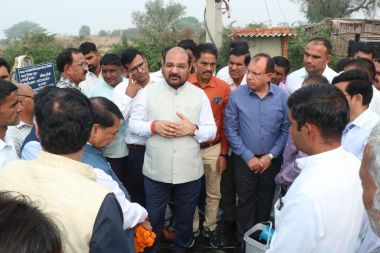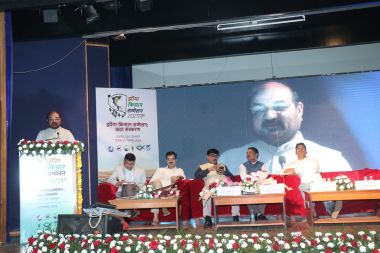1 November 2025, Churu, Rajasthan
ICAR–Central Institute of Brackishwater Aquaculture, Chennai, organized the 6th Edition of the Shrimp Farmers’ Conclave at Rajgarh, District Churu, Rajasthan, today. The conclave aimed to establish direct interaction with shrimp farmers, address region-specific challenges, and promote sustainable brackishwater aquaculture in the inland saline regions of western India.
Shri Rahul Kaswan, Member of Parliament, Churu, emphasized the immense potential of Churu for shrimp farming and called for the inclusion of shrimp culture under the agricultural insurance framework. He urged collective efforts to make Churu a leading centre for shrimp production in India.
Dr. M.L. Jat, Secretary (DARE) & Director General (ICAR), highlighted the immense potential of saline aquaculture in Rajasthan and emphasized the development of infrastructure and detailed project reports for sustainable shrimp farming. He also encouraged diversification into high-value horticultural crops such as date palm and dragon fruit, and suggested integrating shrimp farming with agrotourism initiatives. Earlier in the day, Dr. Jat visited a shrimp farm in the region and interacted with farmers during field demonstrations.

Distinguished participants also included Dr. J. K. Jena, Deputy Director General (Fisheries), ICAR; Dr. Rajbir Singh, Deputy Director General (Agri Extension), ICAR; Dr. N. P. Sahoo, Chief Executive, National Fisheries Development Board; Dr. Kuldeep K. Lal, Director, ICAR-CIBA, along with senior officials from state fisheries departments, local administration, and more than 200 farmers and stakeholders.
Dr. Jena, underscored that India’s shrimp exports contribute approximately ₹46,000 crore annually. He noted that inland regions like Churu, with minimal risk of viral diseases prevalent in coastal zones, could become hubs for disease-free shrimp production. He advised farmers to source healthy seed and follow best management practices.
Dr. Rajbir Singh, emphasized the role of Krishi Vigyan Kendras (KVKs) as vital training and capacity-building centres for promoting shrimp farming in inland areas.
Welcoming the dignitaries, Dr. Kuldeep K. Lal, elaborated on the institute’s series of region-specific shrimp farmer conclaves and presented insights from the aquaculture potential mapping conducted for Rajasthan. Using space technology and ground surveys, CIBA identified 35,277 hectares across seven districts suitable for aquaculture development. He also highlighted collaborations for producing locally formulated shrimp feed based on Vanami Plus technology.
The dignitaries released a manual on shrimp farming and the EHP CURA-I mobile application (in Hindi). An insurance policy was handed over to beneficiary Mrs. Smita Rajawat, and EHP CURA-I (5-litre cans) were distributed to six progressive farmers.

Inland shrimp farming, a unique aquaculture system utilizing saline groundwater, has emerged as a significant economic activity in north-western India. The region currently supports approximately 8,000 acres of commercial shrimp ponds, producing nearly 10,000 tonnes of shrimp annually.
The technical sessions featured expert presentations on emerging aquaculture technologies, disease management, use of EHP CURA-I, and the newly launched shrimp crop insurance scheme a pioneering initiative in India. The insurance policy, developed with ICAR-CIBA’s technical support and in partnership with five insurance companies, now extends coverage for shrimp diseases and is endorsed by the National Fisheries Development Board (NFDB).
ICAR-CIBA’s region-specific farmer conclaves have become an effective platform for bridging the gap between researchers, policymakers, and farmers. These events promote the adoption of innovative technologies, enhance farmer awareness, and ensure that all communication materials are made available in local languages for wider reach.
The 6th edition of the Shrimp Farmers’ Conclave marks another milestone in ICAR-CIBA’s continued efforts to strengthen sustainable brackishwater aquaculture and transform inland saline areas into vibrant aquaculture hubs.
(Source: ICAR-Central Institute of Brackishwater Aquaculture, Chennai)







फेसबुक पर लाइक करें
यूट्यूब पर सदस्यता लें
X पर फॉलो करना X
इंस्टाग्राम पर लाइक करें